
Kurs aus TUMOnline ( W2021/22)
New technologies shift existing social and cultural concepts: the real constitutes itself by opposition to the virtual, digitality produces a concept of the analogous; and, most recently, artifical intelligence forces us to reimagine the human in itself.
Cultural products have long commented upon technological change. In this class, we will read and watch theater and film adaptations of William Shakespeare's "Hamlet" that all attempt to understand a technological revolution: In 1601, a ghost is used to reflect upon the virtuality of the printed text one century after the invention of the printing press. 400 years later, actors grapple with the existence of a digital text that magically appears on screen at the Münchener Kammerspiele. In the TV series "Westworld", "Hamlet" is used to understand a world in which humans exist alongside robots who, in the end, become just as human as their creators.
Literature, theater and film show us that technological change deeply shapes not only our technological advancement and daily lives, but our understanding of our human reality at large.
Cultural products have long commented upon technological change. In this class, we will read and watch theater and film adaptations of William Shakespeare's "Hamlet" that all attempt to understand a technological revolution: In 1601, a ghost is used to reflect upon the virtuality of the printed text one century after the invention of the printing press. 400 years later, actors grapple with the existence of a digital text that magically appears on screen at the Münchener Kammerspiele. In the TV series "Westworld", "Hamlet" is used to understand a world in which humans exist alongside robots who, in the end, become just as human as their creators.
Literature, theater and film show us that technological change deeply shapes not only our technological advancement and daily lives, but our understanding of our human reality at large.
Our five sessions include – one introductory session; - one session on Shakespeare's Hamlet (1603) and the technological revolution it adresses (technological transformation I); - one session on Christopher Rüping's staging of Hamlet (2017) and the relation between the printed and the digital text; - one session on Jonathan Nolan's Westworld (2016) as an adaptation of Hamlet dealing with the difference between the human and the non-human. Each session will include an oral presentation of our primary material – dramatic text, staging, or film adaptation – as well as theoretical or methodical input. We will then divide into groups and work on an analysis with regards to specific questions. One extra-ordinary session will consist in a visit to the theater and hopefully an encounter with some of the team members! After the end of our class, you will pick one of our primary objects OR the theater performance we saw together to write a short essay about.
- Dozent: Elisa Leroy
- Dozent: Franziska Recknagel
